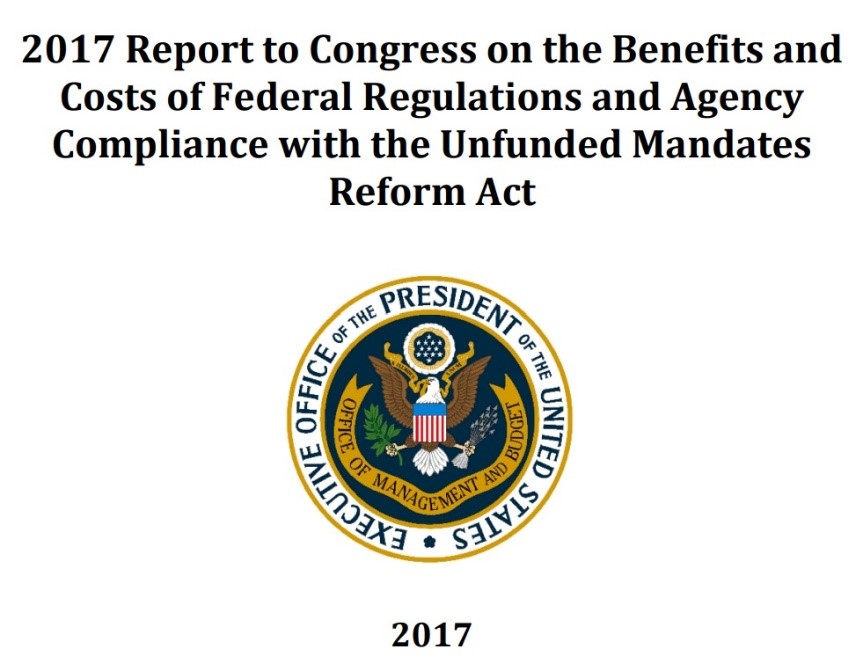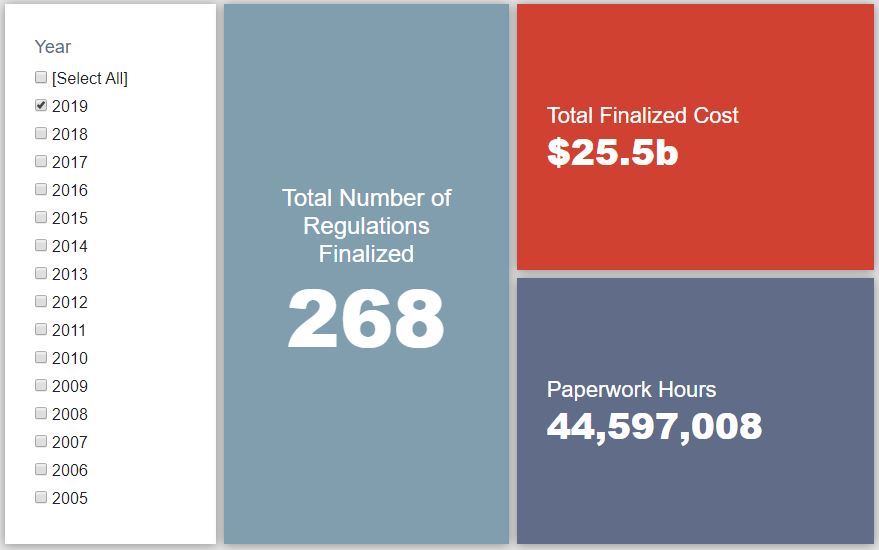Week in Regulation
December 16, 2019
A Blast From the Past
This past week there was a Securities and Exchange Commission (SEC) proposal with substantial increases in paperwork requirements and then not much else. Outside of the pages of the Federal Register, the most notable event was the long-awaited release of the “2017 edition” of the administration’s report on cost and benefits from major rules. Across all rulemakings, agencies published $739.7 million in total net costs and added 1.3 million hours of annual paperwork.
REGULATORY TOPLINES
- New Proposed Rules: 34
- New Final Rules: 64
- 2019 Total Pages: 68,203
- 2019 Final Rule Costs: $25.5 Billion
- 2019 Proposed Rule Costs: $54.2 Billion
The most significant rulemaking of the week was an SEC proposed rule regarding “Investment Adviser Advertisements; Compensation for Solicitations.” The proposal seeks to update “the rules that prohibit certain investment adviser advertisements and payments to solicitors” that have apparently gone unchanged since 1979. These changes could produce roughly two million more hours of paperwork with $811 million in commensurate costs. Since SEC is an independent agency, this sum does not apply to the regulatory budget under Executive Order (EO) 13,771.
TRACKING THE REGULATORY BUDGET
The most notable action that does apply to the fiscal year (FY) 2020 regulatory budget is a final rule from the Environmental Protection Agency (EPA) on “Increasing Recycling: Adding Aerosol Cans to the Universal Waste Regulations.” According to the agency, this measure “is adding hazardous waste aerosol cans to the universal waste program under the Federal Resource Conservation and Recovery Act (RCRA) regulations.” EPA explains that this more standardized set of rules could provide affected entities with savings of roughly $5.3 million annually, or nearly $66 million in net present value.
The Trump Administration expects to reach $51.6 billion in cumulative net savings in FY 2020. To date in the fiscal year, agencies have finalized 28 deregulatory actions and 10 regulatory actions, totaling $592 million in quantified total net costs. This sizeable shift from last week’s estimate of $1.7 billion is due to the elimination of a handful of rules that actually applied to FY 2019 despite being published in FY 2020
THIS WEEK’S REGULATORY PICTURE
This week, the Office of Information and Regulatory Affairs (OIRA) goes back to the future to issue a mandated report.

On December 9, 2019 OIRA released its 2017 Report to Congress on the Benefits and Costs of Federal Regulations and Agency Compliance with the Unfunded Mandates Reform Act (yes, you read that correctly). OIRA is required to annually submit the report to Congress under the Regulatory Right-to-Know Act. This is the first report submitted by OIRA during the Trump Administration, though it is unclear why the report has only now been completed.
Aside from the tardiness, the report is notable mostly for what it is and what it is not. The report simply inventories major regulations (those with $100 million or more in annual impacts) with estimated costs or benefits that have been issued over the previous 10 fiscal years. It does not analyze any rules retrospectively to see if the stated benefits and costs are accurate. Also, as the second sentence of the report correctly warns: “It does not purport to calculate all costs or benefits from federal regulation; instead, the report summarizes the anticipated costs and benefits that the Regulatory Impact Analyses (RIAs) of individual final rules reported for those rules, as estimated at the time the rules were issued.”
Many cite the report as evidence that federal regulation yields benefits that outweigh costs by several factors. One should consider the incentives of agencies when preparing benefit-cost analyses, however. In order to get a regulation through agency and OIRA review (and increasingly, to have the rule hold up in court), the stated benefits should outweigh the stated costs. This makes agencies far more likely to seek out and quantify possible benefits than costs. So of course, any report that merely inventories these figures would show benefits that outweigh costs.
A better analysis would be to look back at significant regulations to check the accuracy of benefits and costs issued years earlier. Perhaps Congress should consider mandating such a report be issued in place of the one released this week.
TOTAL BURDENS
Since January 1, the federal government has published $79.7 billion in total net costs (with $25.5 billion in finalized costs) and 58.6 million hours of net annual paperwork burden increases (with 44.6 million coming from final rules). Click here for the latest Reg Rodeo findings.












